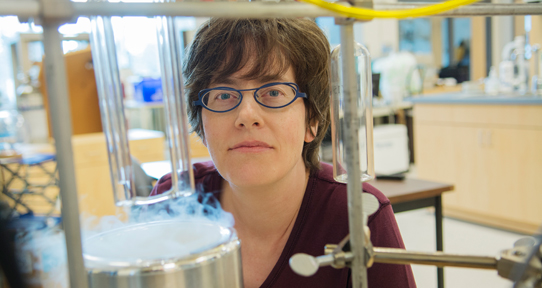Why we need the ocean

UVic research probes the critical link between the ocean and climate change
by Valerie Shore
The ocean means many things to many people. We eat from it. We work and play on and in it. We breathe much of our oxygen from it. And we get our weather from it, no matter where we live.
And there’s another essential but lesser-known role that the ocean plays in our lives—it acts as a natural storage bin for carbon dioxide, the notorious greenhouse gas that we’ve been belching into the atmosphere since the dawn of the Industrial Age.
“Few people realize that the ocean controls the level of carbon dioxide in the atmosphere, and that it currently absorbs just over one-third of the excess carbon dioxide we produce,” says Roberta Hamme, a chemical oceanographer at the University of Victoria.
She should know. As the Canada Research Chair in Ocean Carbon Dynamics, Hamme is shedding new light on how carbon moves through the ocean and how we can use this knowledge to predict the progression of global climate change.
Carbon is a chemical element vital to all living things and circulates around the planet in what’s called the carbon cycle. Where air and ocean meet there’s a constant interchange of gases, including carbon dioxide. While most of it remains a dissolved gas and is left to the whims of ocean mixing, some of the carbon gets turned into organic matter and eventually sinks into the deep ocean, stored away from the atmosphere for hundreds of years.
“Almost 90 per cent of carbon in the ocean/atmosphere/terrestrial system is in the ocean in one form or another,” says Hamme. “That makes the ocean the big carbon player in the room.”
The problem now is that the ocean can’t keep up with us, says Hamme. “We’re burning fossil fuels and putting carbon dioxide into the atmosphere at a faster rate than the ocean can take it up. It’s out of equilibrium.”
To learn more about where carbon goes in the ocean and how, Hamme is probing the ocean carbon cycle from various angles—biological productivity, the nitrogen cycle, and gases carried by deep-ocean currents.
The ocean carbon cycle is very slow, Hamme explains. It takes about 1,000 years for ocean water to “turn over” and see the surface again. This happens at only two spots in the world—the North Atlantic and the Southern Ocean near Antarctica.
In one project, Hamme studies the influence of physical factors such as wind, water temperature and bubbles on gas transport. To do this, she and her graduate students collect water samples from places such as the Labrador Sea and make ultra-precise measurements of proxy gases such as argon that are not biologically active.
“What I get is a fingerprint of the processes that are happening when deep water forms. Then I can take that information and apply it to gases such as carbon dioxide or oxygen that are biologically active.”
Hamme posts her data online for other researchers and is working with scientists who are developing climate models for predicting future climate change. “The idea is to improve the accuracy of these models,” she says.
“The ocean carbon cycle is complex, but we’re beginning to understand it,” says Hamme. “The new techniques we’re developing, and the new places and ways we’re observing the ocean mean that we’re making progress on getting answers to our questions.”
View as PDF (316 KB).
Carbon dioxide is naturally exchanged between ocean, atmosphere and land surfaces as it’s produced and absorbed by micro-organisms, plants and animals. An individual carbon atom may pass through the cycle in a matter of days, or stay trapped in the deep ocean for thousands of years.
Human activities are altering the carbon cycle by adding more carbon dioxide to the atmosphere, mainly through the burning of fossil fuels such as coal, natural gas and oil. Carbon dioxide is a greenhouse gas that prevents heat escaping from the planet, resulting in temperature increases.
Roberta Hamme’s graduate students are heavily involved with her research, every year going on research cruises to collect water samples for analysis. She also brings her research into the classroom, helping students understand the complex physical and biological mechanisms involved in the carbon cycle.
UVic is a world leader in ocean and climate science and clean technology development. Our researchers are providing the critical knowledge needed to inform decisions by communities, governments and industry on climate change mitigation and adaptation, and on sustainable ocean management.
June 8 is World Oceans Day, a worldwide celebration of the major role that the ocean plays in our lives, whether we live on the coast or inland. UVic’s world-leading Ocean Networks Canada is co-hosting and participating in several events.
